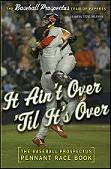Here's a few Coors Field tidbits that I gleaned from the Rockies media guide. I was reminded of these after seeing the Rockies low-scoring 3-2 and 3-1 victories the last two days.
- No Rockies pitcher has thrown two complete game shutouts at Coors. Only five Rockies pitchers have thrown complete game shutouts: Mark Thompson, Roger Bailey, Brian Bohanon, Mike Hampton, and John Thomson. Meanwhile Tom Glavine has done it twice both I 1995 and 1997
- On April 26th Juan Pierre hit his first career homerun at Coors on his 729th at bat. He had been the record holder for most at bats without one. Now that falls to Pedro Astacio at 137 at bats
- The Rockies set a record for most consecutive home games scoring at least one run at 361 from 7/5/99 to 9/17/2003. That's over 100 games longer than the previous streak of 258 held by the Boston Braves 1892-1896
- 10 homeruns have been hit in a game five times, most recently 7/2/2002 vs. the Giants when the Rockies hit 3 and the Giants 7
- The 303 homeruns hit there in 1999 is the Major League record (3.7 per game)
- The longest homerun at Coors is 496 feet by Mike Piazza 9/26/97. Larry Walker is second at 493 on 8/31/97
- There has never been a 1-0 game in 801 contests going into this season. The old record was 635 games for the Philadelphia A's (1882-1891)
- There have only been two 2-0 games, one was one of the Glavine shutouts
Although the last two days have been low scoring the simple park factor calculated as:
PF = ((homeRS + homeRA)/(homeG)) / ((roadRS + roadRA)/(roadG))
has Coors Field up around 1.48 for 2005, second only to Jacobs Field. The Rockies have scored 133 runs at home and just 55 on the road while their opponents have scored 131 at Coors and 89 away. Overall that's 12.57 runs per game at Coors as opposed to 8.47 on the road.
Historically, the park factors as calculated by Baseball Reference (using three year weighted averages have been:
Year BPF/PPF
2004 120/117
2003 112/111
2002 121/119
2001 122/119
2000 131/128
1999 129/126
1998 119/120
1997 123/123
1996 129/129
1995 128/128
1994 116/118
1993 120/122
It's interesting that park factors have been decreasing in recent years. Most people attribute this to the humidor that was installed at Coors Field in 2002 to keep the balls at 70 degrees and 50% humidity. There was an great article by Mike Klis of the Denver Post online today that talks about the humidor. I found the following interesting.
"The Rockies believe the pitching problems at Coors Field could be at least partially corrected if the weight specifications MLB has for its baseballs weren't contradictory to its humidor/ball-shipping specifications. By rule, a baseball can weigh from 5.0 to 5.25 ounces and measure from 9.0 to 9.25 inches in circumference.
This is not an insignificant variance. MLB's own study at the University of Massachusetts-Lowell in 2000 found that a well-struck, 5.25-ounce, 9.25- inch ball could travel up to 49.1 feet less than a 5.0-ounce, 9.0- inch ball.
The current humidor settings, however, cannot sufficiently offset altitude's effects to pump the baseballs up to 5.25 ounces. According to Kevin Kahn, the Rockies' chief of ballpark operations, and humidor engineering head Tony Cowell, the balls put in play at Coors Field weigh about 5.12 ounces, on average. "
According to Cowell, prior to the humidor balls were being put into play with weights as low as 4.6 ounces and 8.5 inches.
Cowell is pictured below.

Although I don't doubt that the humidor has had an impact you'll note that scoring began to decline in 2001, the height of the offensive outburst of recent years. Perhaps that was just a fluke.
125x125_10off+copy.jpg)



No comments:
Post a Comment